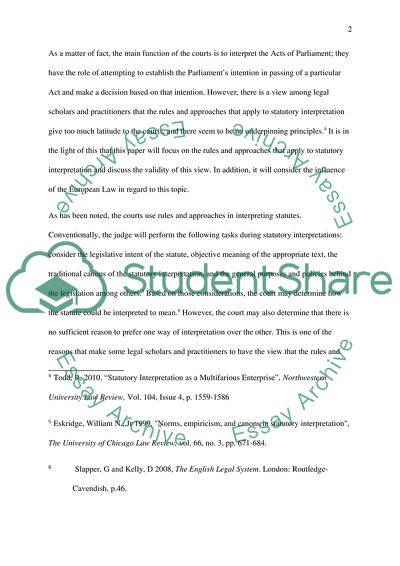Cite this document
(Rules of Statutory Interpretation Essay Example | Topics and Well Written Essays - 2250 words, n.d.)
Rules of Statutory Interpretation Essay Example | Topics and Well Written Essays - 2250 words. https://studentshare.org/law/1768236-the-rules-and-approaches-that-apply-to-statutory-interpretation-give-too-much-latitude-to-the-courts-and-it-seems-there-are-no-underpinning-principles-discuss-the-validity-of-this-view-and-consider-the-influence-of-the-europ
Rules of Statutory Interpretation Essay Example | Topics and Well Written Essays - 2250 words. https://studentshare.org/law/1768236-the-rules-and-approaches-that-apply-to-statutory-interpretation-give-too-much-latitude-to-the-courts-and-it-seems-there-are-no-underpinning-principles-discuss-the-validity-of-this-view-and-consider-the-influence-of-the-europ
(Rules of Statutory Interpretation Essay Example | Topics and Well Written Essays - 2250 Words)
Rules of Statutory Interpretation Essay Example | Topics and Well Written Essays - 2250 Words. https://studentshare.org/law/1768236-the-rules-and-approaches-that-apply-to-statutory-interpretation-give-too-much-latitude-to-the-courts-and-it-seems-there-are-no-underpinning-principles-discuss-the-validity-of-this-view-and-consider-the-influence-of-the-europ.
Rules of Statutory Interpretation Essay Example | Topics and Well Written Essays - 2250 Words. https://studentshare.org/law/1768236-the-rules-and-approaches-that-apply-to-statutory-interpretation-give-too-much-latitude-to-the-courts-and-it-seems-there-are-no-underpinning-principles-discuss-the-validity-of-this-view-and-consider-the-influence-of-the-europ.
“Rules of Statutory Interpretation Essay Example | Topics and Well Written Essays - 2250 Words”. https://studentshare.org/law/1768236-the-rules-and-approaches-that-apply-to-statutory-interpretation-give-too-much-latitude-to-the-courts-and-it-seems-there-are-no-underpinning-principles-discuss-the-validity-of-this-view-and-consider-the-influence-of-the-europ.


